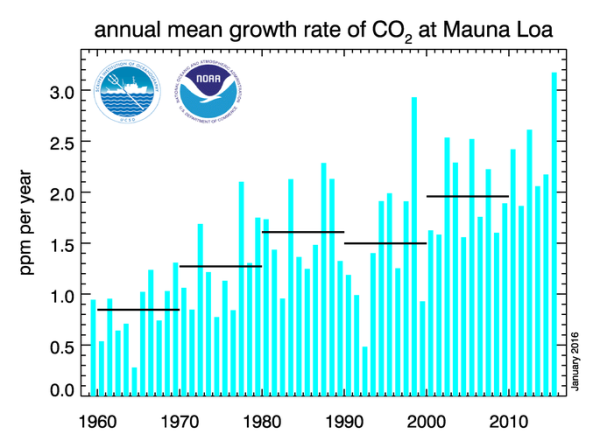http://robertscribbler.com/2016/02/05/co2-rockets-to-405-6-ppm-a-level-not-seen-in-15-million-years/
EXCERPT:
As CO2 levels hit a new record global high of 405.66 ppm yesterday, I couldn’t help but think that HG Wells could not have imagined a more perilous mechanism for exploring the world’s past.
For when it comes to testing the range of new climate extremes, the present mass burning of fossil fuels is like stepping into a dark time machine. As all that carbon hits the airs and waters, the climate dial spins backward through hundreds of thousands and millions of years. Speeding us on toward the hothouse extinction eras of Earth’s deep history. Now, not only is it driving us on through extreme weather and temperature events not seen in 100, 1,000, 5,000 or even 10,000 years, it is also propelling us toward climate states that haven’t occurred on Earth for ages and ages.
*****
Ever since 1990, the world has experienced atmospheric CO2 levels in a range that hasn’t been seen since the Pliocene geological epoch. A period of time 2.6 – 5.3 million years ago hosting carbon dioxide levels ranging from 350 to 405 parts per million and global average temperatures that were 2-3 degrees Celsius hotter than 1880s levels. Overall, global sea levels towered about 80 feet higher than those humankind has grown accustomed to.
(Never has the Earth seen a CO2 build-up so rapid as the one produced by the human fossil fuel energy era. Rates of CO2 increase just keep ramping higher ever as the world’s climate sinks appear to be filling up. In this context, 2015 saw the swiftest pace of CO2 rise yet. Warming ocean surface waters can’t absorb as much CO2 as cooler oceans. And a record hot ocean during 2015 contributed to this extreme atmospheric CO2 accumulation. For the whole of the past year, CO2 built up in the atmosphere at a rate of 3.2 parts per million per annum. That’s well above the already raging pace of 2 parts per million average annual accumulation during the decade of the 2000s. Image source: NOAA ESRL.)
If global atmospheric CO2 levels had stabilized in this range, it’s likely that we would have eventually seen climates, temperatures, and sea levels that became more and more like those experienced 2-5 million years ago. A process that would have likely taken centuries to reach a final, far warmer climate state. One in which little to no ice remained upon Greenland or West Antarctica, and one hosting a substantial retreat of coastlines.
From 1990 through 2015, that was our climate context. The new world that was steadily settling into place. One that would eventually assert itself unless atmospheric CO2 levels were somehow drawn down to below 350 parts per million. It was kind of a big deal. Unfortunately, few experts really talked about it.


No comments:
Post a Comment